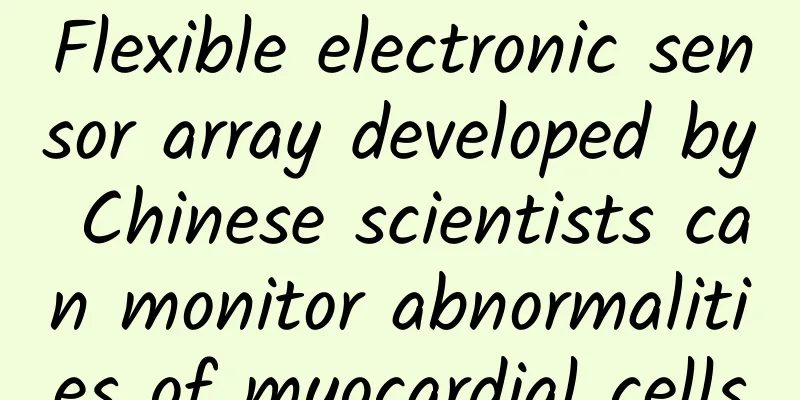Flexible electronic sensor array developed by Chinese scientists can monitor abnormalities of myocardial cells

|
Heart disease has been the number one killer for the past 20 years, accounting for 16% of all deaths. Recently, researchers at the University of California, San Diego, developed a flexible electronic sensor array that can monitor the conduction of electrical signals within and between cardiomyocytes. It is expected to achieve intracellular signal detection and study signal conduction between different organelles within cells, or it can be used to test how new drugs affect heart cells and tissues. The research results were published in Nature Nanotechnology on December 23, 2021. The tiny "pop-up" sensor enters cells without damaging them and directly measures the conduction and speed of electrical signals within individual heart cells, allowing for high-resolution pictures of the heart's interior. Sensor under an optical microscope | Photo courtesy of Xu Sheng The Guokr editorial team contacted the researchers immediately. The first author of the article, Gu Yue, told Guokr: "'High resolution' means that the same device can be equipped with multiple sensors per unit area of myocardial tissue to obtain more detailed information in a limited space; 'image' refers to the path diagram of electrical signals transmitted between cells and within cells. Based on this, we can see which cells are malfunctioning, where the activity is out of sync with other places, and accurately point out where the signal is weak." "The information provided by the sensor can help clinicians make better diagnoses," said Sheng Xu, a professor of nanomaterials at the UC San Diego Jacobs School of Engineering. How does the device work? The sensor is made up of a three-dimensional array of tiny field-effect transistors, or FETs, shaped like a prong. These tiny FETs can penetrate cell membranes without damaging them and are so sensitive that they can detect very weak electrical signals directly inside cells. Sensor morphology under scanning electron microscope | Image provided by Xu Sheng The surface of FET is modified with a phospholipid bilayer, and the process of entering the cell is similar to that of a vesicle or liposome entering the cell - when the modified FET approaches the cell, the phospholipids on its surface will spontaneously fuse with the cell membrane. This can prevent it from being treated as a foreign body by the cell and make it easier to enter the cell. In addition, after entering the cell, the FET can form a close and stable contact with the cell membrane, making its test longer and more accurate. Illustration of the device interfaced with heart cells, where the sensor can simultaneously monitor the electrical signals of multiple single cells (bottom left) and two locations within a cell (bottom right) | Nature Nanotechnology [3] If multiple independent sensors are designed on a device, when the device is used to test cell signals, if these sensors each test different cells, the electrical signals studied are the transmission between these cells (intercellular conduction). "Gu Yue explained, "Another case is that if two adjacent sensors monitor different locations of the same cell, what is obtained is the conduction of signals inside the cell (intracellular conduction). " Currently, the detailed information about how electrical signals are transmitted within a single cell is unknown. "That's what's unique about this device," said Gu Yue, "it allows two sensors to penetrate the cell membrane of the same cell in a minimally invasive way, allowing us to see the direction of signal transmission within the same cell and how fast it is transmitted." How to make a device that enters a cell? "Studying how electrical signals are transmitted between different cells is very important for understanding cell function and disease mechanisms," said Gu Yue. "For example, if the signal shows abnormalities, it may be a sign of arrhythmia. If electrical signals cannot be transmitted normally, certain parts of the heart cannot receive the signals and thus cannot contract." Scanned images of the device in its two-dimensional form (left) and folded into a three-dimensional structure (right) | Nature Nanotechnology [3] To build this device, the team first made the field effect transistor into a two-dimensional sheet, and then transferred this two-dimensional device to a pre-stretched silicone elastomer substrate. When the pre-stretching force is released, the original two-dimensional structure is subjected to a squeezing force, under the action of this squeezing force, the two-dimensional structure will be deformed into a three-dimensional structure. "This sensor is like a pop-up book," Gu said. "It starts out as a two-dimensional structure, and under pressure some parts pop out, forming a three-dimensional structure." How is the monitoring effect? The research team tested the sensor on both cardiomyocytes and heart tissue cultured in vitro. The experiment placed the cell culture or tissue on the device and then monitored the electrical signals received by the field-effect transistor sensor. By observing which sensors detected the signal first and how long it took for other sensors to detect the signal, the research team can determine how and how fast the signal is transmitted, and can also measure the signals of neighboring cells - this is also the first time in the field that signals within a single cardiomyocyte have been measured. The traditional patch clamp technique used to monitor cell electrical signals is still the most widely used intracellular electrophysiological signal technology, but the equipment is very difficult to operate, and the invasive measurement method can easily kill the cells to be tested. Using this sensor with a surface modified phospholipid bilayer can minimize the damage to the cells to be tested, thereby achieving the test of placing two sensors in the same cell. Xu Sheng also introduced that "even better, this is the first time that researchers can measure intracellular signals in three-dimensional tissue structures." So far, signal monitoring in such tissues has only been achieved outside the cell membrane, but this sensor can collect signals in cells within the tissue. A scaled-up FET sensor array device for measuring electrical signals in three-dimensional cardiac tissue structures | Image provided by Yue Gu [2] The research team also found in the experiment that signal conduction within a single cardiomyocyte is nearly five times faster than that between multiple heart cells. Gu Yue believes that studying these issues can reveal the causes of heart abnormalities at the cellular level. "Suppose that the signal conduction speed within a single cell and the signal conduction speed between two cells are measured. If the measurement results show that the speed of intercellular conduction is much slower than the speed of intracellular conduction, then it is likely that there is a problem with the connection between cells, such as fibrosis." What are the prospects for industrialization? One of the most basic application directions of this device is that it can replace the traditional patch clamp technology to a certain extent in the future and be used for monitoring intracellular electrophysiological signals. In addition to the extremely high requirements for operator skills and experience, which prevents it from being promoted on a larger scale, the patch clamp technology is also difficult to apply to simultaneously record the signals of multiple cells, so it is rarely used to study the conduction properties of electrical signals. However, the tool introduced in this study has advantages in both aspects. Next, the team will study the electrical signal activity inside neurons. The researchers plan to use this device to record the electrical activity of real biological tissue in living bodies. Xu Sheng envisions a device that can be implanted on the surface of a beating heart or the surface of the cerebral cortex, but the current device is still a long way from reaching this stage. To achieve this goal, researchers also need to conduct in-depth research on adjusting the FET sensor layout, optimizing the size and materials of the FET array, and integrating artificial intelligence-assisted signal processing algorithms into the device. "Industrialization is also an aspect that we are very interested in." Gu Yue told Guokr, "The equipment preparation process introduced in this study is relatively new, and the new process still needs to formulate corresponding composite industrial production standards. On the other hand, this preparation technology is customizable. Different structures of equipment can be designed for different types of cells or research contents. If we want to embark on the road of industrialization, how to formulate a set of design standards and guidelines is also a problem that needs to be solved." Acknowledgements We would like to thank Assistant Professor Xu Sheng and Dr. Gu Yue from the Department of Nanoengineering at the University of California, San Diego for their review and suggestions on this article. Author: Crispy Fish Editor: Jin Xiaoming Typesetting: Washing dishes References [1]https://www.eurekalert.org/news-releases/938733 [2]https://ucsdnews.ucsd.edu/pressrelease/pop-up-electronic-sensors-could-detect-when-individual-heart-cells-misbehave [3]https://www.nature.com/articles/s41565-021-01040-w [4]https://engineeringcommunity.nature.com/posts/intra-and-inter-cellular-recording-by-a-3d-transistor-array Research Team The corresponding author, Xu Sheng, is an assistant professor in the Department of Nanoengineering at the University of California, San Diego. He received his undergraduate degree from the School of Chemistry and Molecular Engineering at Peking University and his Ph.D. in Materials Science and Engineering from the Georgia Institute of Technology. He worked as a postdoctoral researcher in the Department of Materials Science and Engineering at the University of Illinois at Urbana-Champaign. His main research areas are flexible electronic devices and nanomaterials, and he is the winner of the 2021 Sloan Research Fellowship. Home page of the research group: http://xugroup.ucsd.edu/ The first author, Yue Gu, is a Ph.D. from Xu Sheng’s group in the Department of Nanoengineering at the University of California, San Diego, and a postdoctoral fellow at Yale University. Xu Sheng's team "Fu Lin Men" | Photo provided by Xu Sheng Paper Information Published in Nature Nanotechnology Release time: December 23, 2021 Paper Title Three-dimensional transistor arrays for intra- and inter-cellular recording Article fields: Nanomaterials, Medicine, Bioengineering Ji Shisan, the founder of Guokr, said: Having worked as a patch clamp worker in a neuroscience laboratory for six years, I have mixed feelings about the emergence of this new technology... |
<<: Why does Yuan Longping, who has won numerous awards, value foreign awards more?
Recommend
New iPhone will upgrade fingerprint module: less mistakes and more secure
On the morning of February 11, 2015, KGI Securiti...
How to effectively reduce user churn?
Like running a marriage. We gradually get used to...
Two strategies for APP promotion: casting a wide net and focusing on fishing
There is no fancy opening remarks, I will simply ...
Comprehensive analysis of how the treasure hunting platform conducts "category operation"
Operations generally consist of content operation...
Zinc flowers are in full bloom: The truth behind this "flower of life" being named "lead" is...
In junior high school chemistry, we have heard su...
Are there any healthy snacks that won’t make you fat? The truth →
More and more people eat snacks not only to resis...
Moving forward in the cracks: the mobile game market under the new audit policy
Developers in the fog Li Jianhua is the head of a...
Are OK glasses, the “magic weapon” for myopia prevention and control, OK glasses OK or not?
Author: Jin Xin, Director of the Shouyang Myopia,...
What are the Douyin dou+ delivery techniques? Can I gain followers?
There are also many people on Douyin who want to ...
Important reminder! For holiday travel, make these preparations in advance!
The 8-day holiday combining Mid-Autumn Festival a...
Taking Jianshu as an example, let’s explore how UGC content products are cold started!
What is a cold start and how to do it? Is there a...
Understand at a glance: Should we get the “fourth shot” of the new coronavirus vaccine?
Vaccination with the new coronavirus vaccine can ...
WP8.1 preview update: fix a lot of bugs/improve battery life
This morning, Microsoft released the first update ...
Samsung mobile phones have become a thing of the past in the country
Samsung, the only mobile phone manufacturer that c...



![[Bai Gu Jing] Xue Han's advanced study of the Chaos Theory of Stocks: Chaos Theory's price comparison relationship - the secret of sector rotation 8 episodes](/upload/images/67cc2df0e1435.webp)

![WeChat applet development video tutorial compilation [Baidu cloud resource collection]](/upload/images/67cc289212947.webp)



